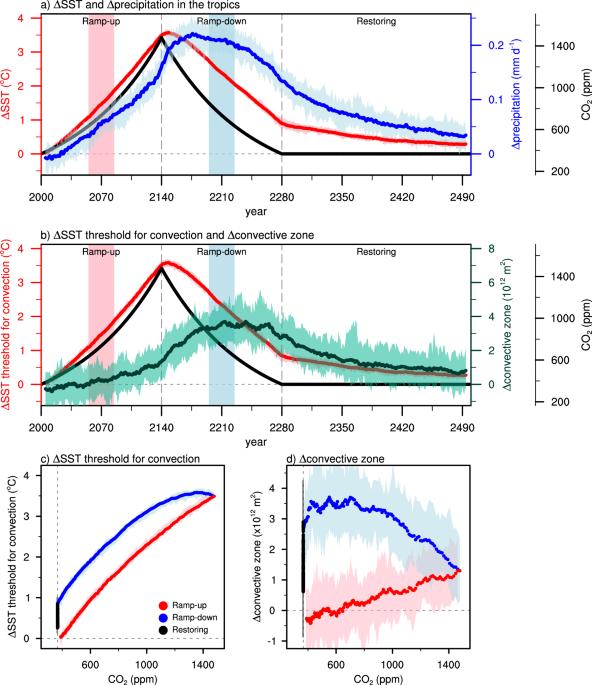Irreversible changes in the sea surface temperature threshold for tropical convection to CO2 forcing
IF 8.1
1区 地球科学
Q1 ENVIRONMENTAL SCIENCES
引用次数: 0
Abstract
Tropical convection plays a critical role in modulating the global climate by influencing climate variability. However, its future projection under climate mitigation scenarios remains uncertain. Here, we found that while the relationship between precipitation intensity and upward motion remains constant regardless of changing CO2 concentrations, the sea surface temperature threshold for tropical convection and the convective zone exhibit hysteretic and irreversible behavior. As the CO2 concentration decreases from its peak (ramp-down), higher tropical ocean temperature leads to higher sea surface temperature thresholds for convection than during the period of increasing CO2 concentration (ramp-up), while convective instability remains the same during both ramp-up and ramp-down. El Niño-like warming during the ramp-down leads to a weakening of the Walker circulation and an expansion of the convective zone in the central to eastern tropical Pacific by a warmer-get-wetter mechanism. Our results suggest that CO2 removal does not guarantee the recovery of tropical convection. The sea surface temperature threshold for tropical convection and convective zones shows irreversible behavior, suggesting that mitigation efforts may not fully offset tropical convective activities, according to results from different climate mitigation scenarios to analyze tropical convection and its physical mechanisms.

热带对流的海面温度阈值对二氧化碳强迫的不可逆变化
热带对流通过影响气候变异性在调节全球气候方面发挥着至关重要的作用。然而,其在气候减缓情景下的未来预测仍不确定。在这里,我们发现,虽然无论二氧化碳浓度如何变化,降水强度与上升运动之间的关系保持不变,但热带对流的海面温度阈值和对流区却表现出滞后和不可逆的行为。当二氧化碳浓度从峰值下降时(上升-下降),较高的热带海洋温度导致对流的海面温度阈值高于二氧化碳浓度上升期间(上升-上升),而对流的不稳定性在上升和下降期间保持不变。在上升期和下降期,对流不稳定性保持不变。在上升期,类似厄尔尼诺现象的变暖导致沃克环流减弱,热带太平洋中部至东部的对流区在变暖变湿的机制下扩大。我们的研究结果表明,去除二氧化碳并不能保证热带对流的恢复。热带对流和对流区的海面温度阈值显示出不可逆的行为,表明根据不同气候减缓情景的结果来分析热带对流及其物理机制,减缓努力可能无法完全抵消热带对流活动。
本文章由计算机程序翻译,如有差异,请以英文原文为准。
求助全文
约1分钟内获得全文
求助全文
来源期刊

Communications Earth & Environment
Earth and Planetary Sciences-General Earth and Planetary Sciences
CiteScore
8.60
自引率
2.50%
发文量
269
审稿时长
26 weeks
期刊介绍:
Communications Earth & Environment is an open access journal from Nature Portfolio publishing high-quality research, reviews and commentary in all areas of the Earth, environmental and planetary sciences. Research papers published by the journal represent significant advances that bring new insight to a specialized area in Earth science, planetary science or environmental science.
Communications Earth & Environment has a 2-year impact factor of 7.9 (2022 Journal Citation Reports®). Articles published in the journal in 2022 were downloaded 1,412,858 times. Median time from submission to the first editorial decision is 8 days.
 求助内容:
求助内容: 应助结果提醒方式:
应助结果提醒方式:


